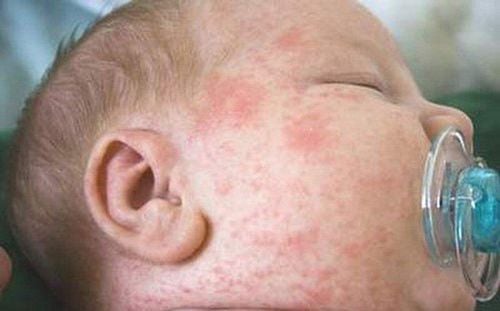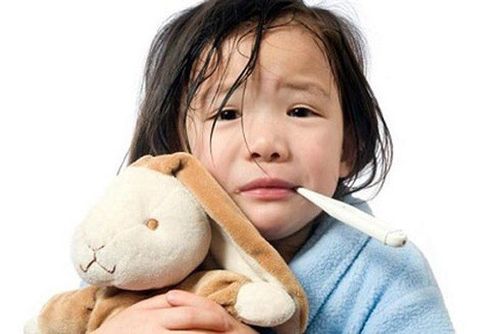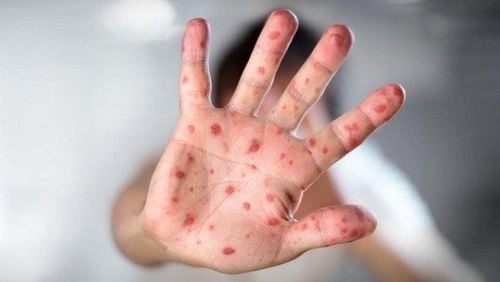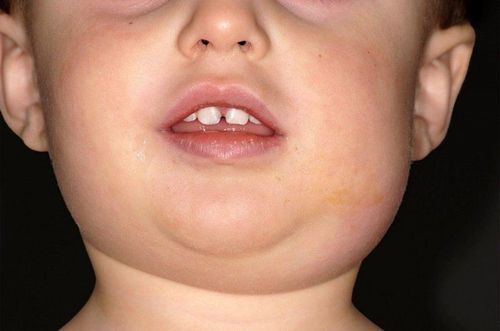This is an automatically translated article.
The article was consulted with Master, Doctor Nguyen Thi An - Pediatrician - Neonatologist - Department of Pediatrics - Neonatology - Vinmec Ha Long International General Hospital.Changes in weather and other factors children are susceptible to diseases such as measles, mumps. Besides, there are gastrointestinal diseases caused by eating unsafe food.
1. Mumps
Mumps is a benign disease. Boys can develop orchitis, which occurs about 7-10 days after swelling of the parotid gland. If not treated promptly, the inflammation worsens, affecting the vas deferens, one of the many causes of infertility. In addition, the baby may also have encephalitis, meningitis, which occurs on the 3rd-10th day with symptoms of high fever, headache, vomiting, sometimes convulsions...The course of mumps is usually mild. , the baby may have a little fever, fatigue, cough; then swelling, pain in one ear and then pain in both sides. If you are suffering from mumps but your baby has abnormal symptoms such as: testicle pain, firm touch (in boys), lower abdominal pain (in girls) or headaches, vomiting... then you need to get sick. hospital for early checkup.
Mumps is caused by a virus, so there is no specific treatment, but only symptomatic treatment such as fever reduction, pain relief... Can warm the parotid gland to reduce pain for the baby; clean baby's teeth; Give your baby liquid, easy-to-digest and nutrient-rich foods to increase the body's resistance.
2. Measles
Measles is a seasonal disease that is common in young children and is a benign disease. Measles has a low mortality rate, but complications can include: otitis media, pneumonia, diarrhea, dry corneal ulcers and sometimes encephalitis after measles, especially for malnourished children. ..Measles symptoms are mild fever or high fever from 39 - 400C, continuous fever. Children with sneezing, runny nose, watery eyes, conjunctivitis, eye discharge, mild eyelid edema, cough (may be dry cough, hoarseness or phlegm), diarrhea. There are small dots about 1 mm raised on the cheek mucosa, easy to see when the child opens his mouth wide; The dot is red, congested, in the same position as the first molar. This sign disappears quickly within 12-18 hours.
After 3 - 4 days of fever, the child develops a rash. At first, the rash grows from behind the ears, gradually spreading to the cheeks, neck, chest, upper limbs, back, lower limbs, to the whole body. The rash is pale pink, smooth, when pressed, it disappears, tends to stick together, the rash is interspersed between healthy skin spaces. In mild form, the rash is scattered, in severe cases, the erythema is thick, almost covering the entire skin, including the palms of the hands and feet, leaving bruises on the skin after flying. Children eat poorly, tired, tired. 3-4 days after the rash grows, the rash will start to fly, the color fades, where it grows first, it will fly first and leave a bruise on the skin, about a week later, there is no trace. The child gradually recovered and the fever was gone.

Sau khi sốt 3 - 4 ngày, trẻ bị phát ban là triệu chứng của bệnh sởi
3. Chickenpox
Chickenpox (also known as varicella) is caused by the Varicella Zoster virus. The disease is transmitted directly through the respiratory tract (cough, sneeze...) or by contact with burning fluid. Chickenpox can occur at any age, is common in children between the ages of 2 and 10, and confers lifelong immunity. In Vietnam, the chickenpox season usually occurs in the spring-summer from February to June of the year.The initial symptoms of chickenpox are fever, headache or muscle aches, fatigue or loss of appetite. After that, red round nodules appear within 12-24 hours, then gradually progress to vesicles at first clear then opaque, emerging in waves on the scalp and trunk. Normally, chickenpox progresses in 5 to 10 days and then goes away. Sometimes chickenpox has complications such as superinfection with vesicles, acute glomerulonephritis, pneumonia ... especially in young children, many cases lead to death.
4. Cold and flu
At the time of the change of season, the weather is very volatile, hot and cold, children are very susceptible to colds and flu due to the immature immune system. Influenza viruses easily enter the body and cause illness.The flu virus spreads from person to person through the respiratory tract, so fast that you don't even know who infected your baby. Children with flu can have fever, stuffy nose, sore throat, cough, sneeze, body aches. Symptoms of stuffy nose, runny nose last longer than other symptoms that make children uncomfortable.
At the time of season change, the elderly and children are very susceptible to colds and flu because their immune systems are incomplete or impaired, making it easier for the flu virus to enter the body and cause illness.
The common cold is caused by a viral infection of the upper respiratory tract, nose and throat. Symptoms of the common cold usually appear about 1-3 days after exposure to a cold virus. Signs and symptoms of the common cold may include: Runny or stuffy nose; Itching or sore throat; Cough; Eye congestion; body aches or mild headache; Sneeze; Weep; Low-grade fever (up to 39 degrees Celsius); Mild fatigue...

Bệnh cảm cúm thông thường là do nhiễm virus đường hô hấp trên, mũi và cổ họng
5. Digestive infections
When the weather begins to change seasons, the syncytial viruses are very developed. This virus is in the air and when it enters the baby's body, it will easily break down the baby's incomplete immune system, making the child more susceptible to digestive infections.Manifestations of gastrointestinal infections are sudden onset of illness and most children with the disease usually have a high fever (38-40 degrees Celsius) and are mostly accompanied by symptoms such as runny nose, stuffy nose, sneezing, coughing. and sore throat.
If the disease is severe, there are manifestations such as watery stools or nausea because the intestines of the children are not yet fully developed, the enzyme activities are still weak, but the nutritional requirements are quite high and at the same time they have to bear the burden of disease. responsibility of the intestine. The nervous system, the circulatory system, the excretory system and the functions of the liver and kidneys in the newborn period are still immature, the regulation function is still poor, and the immune system is not yet mature.
Eating enough quality, ensuring nutrition, eating a lot of fruits to help the body strengthen nutrition, improve resistance. Eating a balance of groups of nutrients: starch, protein, fat, vitamins and minerals... also helps to strengthen resistance, immunity and prevent common diseases in children at better seasons. Parents should supplement their children with supporting products containing lysine, essential micro-minerals and vitamins such as zinc, chromium, selenium, and B vitamins to help fully meet the nutritional needs of children. At the same time, these essential vitamins also support digestion, enhance nutrient absorption, help improve anorexia, and help children eat well.
Parents can learn more:
Signs of zinc deficiency in children
Micronutrient deficiency and failure to gain weight in children
Please regularly visit Vinmec.com website and update useful information to take care of your child. Take care of the baby and the whole family.













